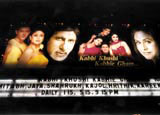Nitin Desai

If there’s one thing really scarce in Bombay it’s land. There’s none left. Every square metre that could have been reclaimed from the sea, has been. Years ago.
But as you enter Film City in the northern suburb of Goregaon, all talk of land at a premium sounds absurd. Spread over hundreds of acres, it’s a different world, with forests, villages, temples, a court room, a college campus and even an airport. All movie sets, of course, for one of the 900-odd Bollywood films made every year.
Nitin Desai has been associated with some of the biggest Bollywood hits in recent years, such as the remake of the classic, Devdas, released this summer, as well as a string of international films including Jane Campion’s Holy Smoke (1999) and the Oscar-nominated Salaam Bombay (1988).
He has succeeded in elevating set design to an art form and secured a position of respect for the set designer. Until Desai burst on the scene in the mid-1980s, set designers took care of props and were one of several assistants of the film’s director.
‘I am more like a production designer now,’ says Desai, whose cane hat has become as much of a trademark in Bollywood as his sets. ‘I keep in mind the director’s needs from the first frame to the last. My sets help translate his vision and script into visuals, so the audience doesn’t just spectate, it participates.’
Desai believes the set designer’s role is as central to a film as that of the script writer and director.
‘Their world is a fantasy – a film’s authenticity comes with the sets. To create the right ambience and era, I study the script to try to understand the director’s vision before I sit down to draw the first sketch – even a rough one – of the sets,’ says Desai, who studied photography at Bombay University.
He first set foot in Film City as assistant set designer for the Indian television series, Tamas, which was based on the human trauma of the subcontinent’s partition. It was a hit. The director, Govind Nilhani, was already known as one of the finest film-makers in the country and Desai soon got noticed, too. ‘I still remember the day, 7 May 1985, when I first came [to Film City] to do initial research for Tamas. I didn’t leave for two weeks; I was so excited and engrossed in the project that nothing else seemed to matter,’ Desai recalls. e
e It is this single-minded dedication bordering on obsession that makes seasoned Bollywood directors, including Raj Kapoor, put complete faith in Desai.
One of Desai’s recent sets is for Lagaan, a period drama set in 1894 in a central Indian village, which was nominated for an Oscar this year in the foreign films category.
The success of films like Lagaan in the overseas market is an indication that Bollywood is getting noticed outside India. Desai views the Bollywood season at Selfridges this month in the same light.
‘It’s a great opportunity for Indian cinema, perhaps even greater than Lagaan. Selfridges is a trend-setting department store and a huge tourist attraction. The millions who visit every year go there not just to shop, but to see. What better place and time for Bollywood than to be at Selfridges at this time,’ he says.
Desai did not have to pitch for the Selfridges project. His name was suggested by just about everybody the Selfridges team met during their initial trip last May. But the clincher was a recommendation by Amitabh Bachchan, Bollywood’s leading man.
Desai is working closely with Wilkinson and Selfridges head of marketing services David Snaith.
The initial plan was to feature Indian film subjects throughout the store, both inside and out. But the plan was modified to cover four areas only: the entrance, the central atrium, the food hall and the restaurant.
‘The entrance has been designed to give the look and feel of an Indian cinema showing a film called Bollywood,’ he explains. A garland typifies a traditional Indian welcome and is supposed to purify the thoughts of those entering the premises. A peacock decorates the main entrance, a symbol of good luck and also the national bird of India.
Selfridges’ atrium features an elaborate dancefloor made of marigold flowers, lifted from the Desai-designed set for the film Hum Dil De Chuke Sanam, which means ‘my heart has been given’. A blue velvet cloth depicts the night sky and in the front, three layers of rich velvet in yellow, orange and red represent a sunrise, again an auspicious time to start anything new according to Indian tradition, Desai says.
The Food Hall has been modelled along the lines of a song and dance dream sequence of a Bollywood film where the heroine was made to dance on life-size fruit pieces. And the restaurant has been given the Moghul touch with rich Persian carpets and imperial canopies.
All this and Indian food, too. But as Desai says, ‘The Bollywood season at Selfridges should be a great success, but it will only skim the surface of India’s film industry. There is so much more.’ m
-
Post a comment




